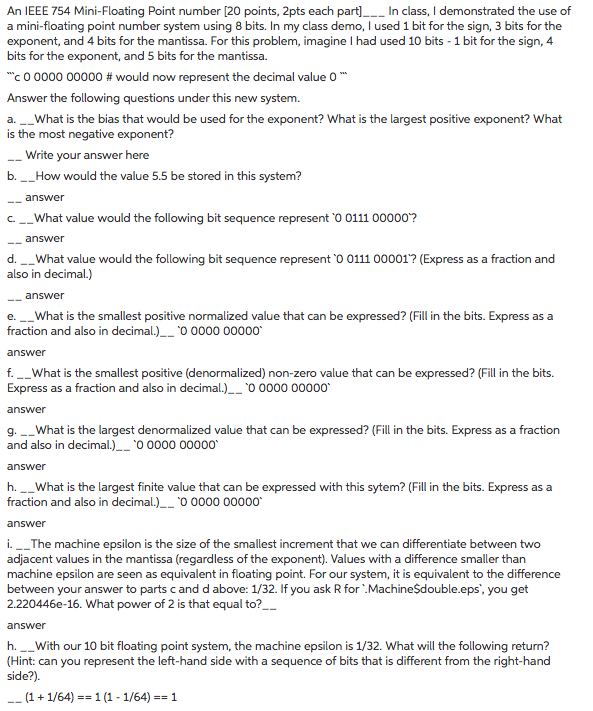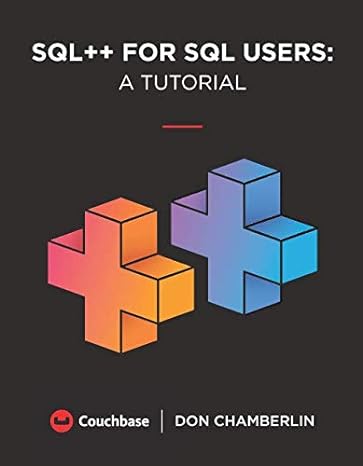
An IEEE 754 Mini-Floating Point number [20 points, 2pts each part]___In class, I demonstrated the use of a mini-floating point number system using 8 bits. In my class demo, I used 1 bit for the sign, 3 bits for the exponent, and 4 bits for the mantissa. For this problem, imagine I had used 10 bits-1 bit for the sign, 4 bits for the exponent, and 5 bits for the mantissa. c 0 0000 00000 # would now represent the decimal value 0 Answer the following questions under this new system. a. __What is the bias that would be used for the exponent? What is the largest positive exponent? What is the most negative exponent? Write your answer hene b. __How would the value 5.5 be stored in this system? c. _What value would the following bit sequence represent 0 0111 00000? d. __What value would the following bit sequence represent 0 0111 00001? (Express as a fraction and answer answer also in decimal.) answer e. _What is the smallest positive normalized value that can be expressed? (Fill in the bits. Express as a fraction and also in decimal.)O 0000 00000 nswer f. __What is the smallest positive (denormalized) non-zero value that can be expressed? (Fill in the bits. Express as a fraction and also in decimal.)0 0000 00000 nswer g. _What is the largest denormalized value that can be expressed? (Fill in the bits. Express as a fraction and also in decimal.)--'0 0000 00000 nswer h._What is the largest finite value that can be expressed with this sytem? (Fill in the bits. Express as a fraction and also in decimal.)O 0000 00000 nswer i._The machine epsilon is the size of the smallest increment that we can differentiate between two adjacent values in the mantissa (regardless of the exponent). Values with a difference smaller than machine epsilon are seen as equivalent in floating point. For our system, it is equivalent to the difference between your answer to parts cand d above: 1/32. If you ask R for.Machinedouble.eps, you get 2.220446e-16. What power of 2 is that equal to? nswer h.__With our 10 bit floating point system, the machine epsilon is 1/32. What will the following return? (Hint: can you represent the left-hand side with a sequence of bits that is different from the right-hand side?) (11/64)1 (1 1/64)1 An IEEE 754 Mini-Floating Point number [20 points, 2pts each part]___In class, I demonstrated the use of a mini-floating point number system using 8 bits. In my class demo, I used 1 bit for the sign, 3 bits for the exponent, and 4 bits for the mantissa. For this problem, imagine I had used 10 bits-1 bit for the sign, 4 bits for the exponent, and 5 bits for the mantissa. c 0 0000 00000 # would now represent the decimal value 0 Answer the following questions under this new system. a. __What is the bias that would be used for the exponent? What is the largest positive exponent? What is the most negative exponent? Write your answer hene b. __How would the value 5.5 be stored in this system? c. _What value would the following bit sequence represent 0 0111 00000? d. __What value would the following bit sequence represent 0 0111 00001? (Express as a fraction and answer answer also in decimal.) answer e. _What is the smallest positive normalized value that can be expressed? (Fill in the bits. Express as a fraction and also in decimal.)O 0000 00000 nswer f. __What is the smallest positive (denormalized) non-zero value that can be expressed? (Fill in the bits. Express as a fraction and also in decimal.)0 0000 00000 nswer g. _What is the largest denormalized value that can be expressed? (Fill in the bits. Express as a fraction and also in decimal.)--'0 0000 00000 nswer h._What is the largest finite value that can be expressed with this sytem? (Fill in the bits. Express as a fraction and also in decimal.)O 0000 00000 nswer i._The machine epsilon is the size of the smallest increment that we can differentiate between two adjacent values in the mantissa (regardless of the exponent). Values with a difference smaller than machine epsilon are seen as equivalent in floating point. For our system, it is equivalent to the difference between your answer to parts cand d above: 1/32. If you ask R for.Machinedouble.eps, you get 2.220446e-16. What power of 2 is that equal to? nswer h.__With our 10 bit floating point system, the machine epsilon is 1/32. What will the following return? (Hint: can you represent the left-hand side with a sequence of bits that is different from the right-hand side?) (11/64)1 (1 1/64)1







